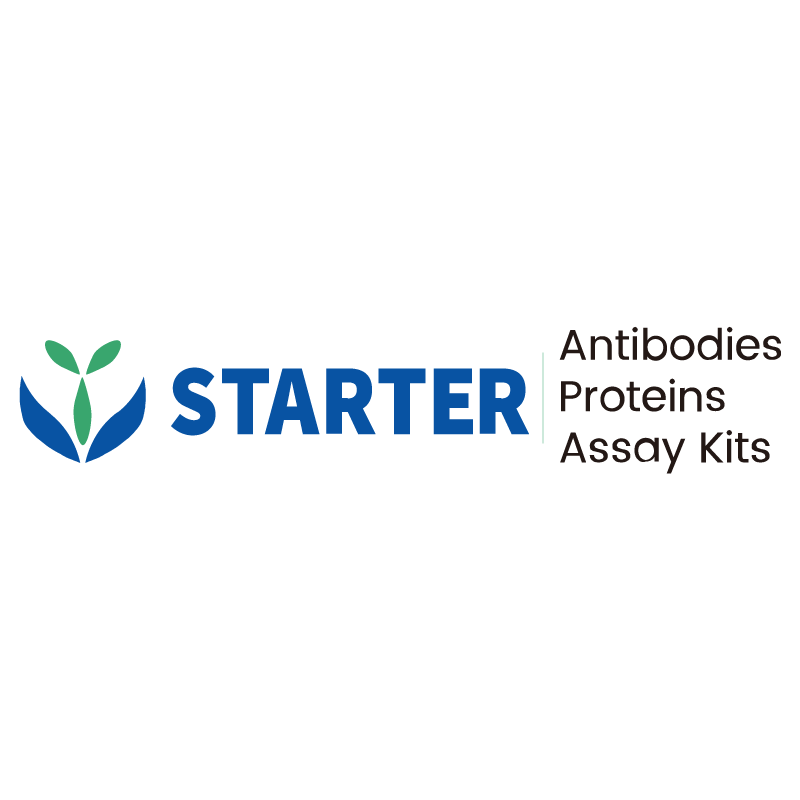WB result of TROP1/EPCAM Recombinant Rabbit mAb
Primary antibody: TROP1/EPCAM Recombinant Rabbit mAb at 1/1000 dilution
Lane 1: NIH/3T3 whole cell lysate 20 µg
Lane 2: mouse colon lysate 20 µg
Negative control: NIH/3T3 whole cell lysate
Secondary antibody: Goat Anti-rabbit IgG, (H+L), HRP conjugated at 1/10000 dilution
Predicted MW: 35 kDa
Observed MW: 30, 38 kDa
Product Details
Product Details
Product Specification
| Host | Rabbit |
| Antigen | TROP1/EPCAM |
| Synonyms | Epithelial cell adhesion molecule; Ep-CAM; Epithelial glycoprotein 314 (EGP314; mEGP314); Protein 289A; Tumor-associated calcium signal transducer 1; CD326; Tacstd1; Epcam |
| Immunogen | Recombinant Protein |
| Location | Cell membrane |
| Accession | Q99JW5 |
| Clone Number | S-1379-5 |
| Antibody Type | Recombinant mAb |
| Isotype | IgG |
| Application | WB, IHC-P, IF |
| Reactivity | Ms, Rt |
| Positive Sample | mouse colon, rat colon |
| Purification | Protein A |
| Concentration | 0.5 mg/ml |
| Conjugation | Unconjugated |
| Physical Appearance | Liquid |
| Storage Buffer | PBS, 40% Glycerol, 0.05% BSA, 0.03% Proclin 300 |
| Stability & Storage | 12 months from date of receipt / reconstitution, -20 °C as supplied |
Dilution
| application | dilution | species |
| WB | 1:1000 | Ms, Rt |
| IHC-P | 1:1000-1:2000 | Ms, Rt |
| IF | 1:500 | Ms, Rt |
Background
TROP1, also known as EpCAM (Epithelial Cellular Adhesion Molecule) or CD326, is a 40 kDa type I transmembrane glycoprotein that plays crucial roles in various cellular processes. It consists of an extracellular domain with two epidermal-growth-factor-like (EGF-like) repeats, a transmembrane segment, and a cytoplasmic domain. EpCAM is highly conserved between species, with 82% amino acid sequence identity between humans and mice. It is expressed in various tissues during embryonic development and in adult simple, pseudo-stratified, and transitional epithelia, but not in normal squamous epithelia or mesenchymal tissues. EpCAM is upregulated in proliferating epithelial tissues, during liver regeneration, and in many carcinomas, making it a potential target for cancer therapy. Functionally, EpCAM acts as a homophilic Ca²⁺-independent adhesion molecule, forming dimers and tetramers that interact with the actin cytoskeleton and regulate cell adhesion, proliferation, and epithelial-to-mesenchymal transition.
Picture
Picture
Western Blot
WB result of TROP1/EPCAM Recombinant Rabbit mAb
Primary antibody: TROP1/EPCAM Recombinant Rabbit mAb at 1/1000 dilution
Lane 1: rat colon lysate 20 µg
Secondary antibody: Goat Anti-rabbit IgG, (H+L), HRP conjugated at 1/10000 dilution
Predicted MW: 35 kDa
Observed MW: 32, 38 kDa
Immunohistochemistry
IHC shows positive staining in paraffin-embedded mouse colon. Anti-TROP1/EPCAM antibody was used at 1/1000 dilution, followed by a HRP Polymer for Mouse & Rabbit IgG (ready to use). Counterstained with hematoxylin. Heat mediated antigen retrieval with Tris/EDTA buffer pH9.0 was performed before commencing with IHC staining protocol.
Negative control: IHC shows negative staining in paraffin-embedded mouse skeletal muscle. Anti-TROP1/EPCAM antibody was used at 1/1000 dilution, followed by a HRP Polymer for Mouse & Rabbit IgG (ready to use). Counterstained with hematoxylin. Heat mediated antigen retrieval with Tris/EDTA buffer pH9.0 was performed before commencing with IHC staining protocol.
IHC shows positive staining in paraffin-embedded rat colon. Anti-TROP1/EPCAM antibody was used at 1/1000 dilution, followed by a HRP Polymer for Mouse & Rabbit IgG (ready to use). Counterstained with hematoxylin. Heat mediated antigen retrieval with Tris/EDTA buffer pH9.0 was performed before commencing with IHC staining protocol.
Negative control: IHC shows negative staining in paraffin-embedded rat skeletal muscle. Anti-TROP1/EPCAM antibody was used at 1/1000 dilution, followed by a HRP Polymer for Mouse & Rabbit IgG (ready to use). Counterstained with hematoxylin. Heat mediated antigen retrieval with Tris/EDTA buffer pH9.0 was performed before commencing with IHC staining protocol.
Immunofluorescence
IF shows positive staining in paraffin-embedded mouse colon. Anti-TROP1/EPCAM antibody was used at 1/500 dilution (Green) and incubated overnight at 4°C. Goat polyclonal Antibody to Rabbit IgG - H&L (Alexa Fluor® 488) was used as secondary antibody at 1/1000 dilution. Counterstained with DAPI (Blue). Heat mediated antigen retrieval with EDTA buffer pH9.0 was performed before commencing with IF staining protocol.
IF shows positive staining in paraffin-embedded rat colon. Anti-TROP1/EPCAM antibody was used at 1/500 dilution (Green) and incubated overnight at 4°C. Goat polyclonal Antibody to Rabbit IgG - H&L (Alexa Fluor® 488) was used as secondary antibody at 1/1000 dilution. Counterstained with DAPI (Blue). Heat mediated antigen retrieval with EDTA buffer pH9.0 was performed before commencing with IF staining protocol.


